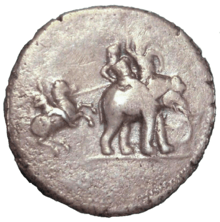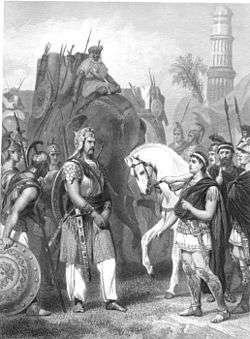Porus
Porus (IPA: [porus]) or Poros (from Ancient Greek: Πῶρος, Pôros), was an ancient Indian king whose territory spanned the region between the Hydaspes (River of Jhelum) and Acesines (Chenab River), in the Punjab region of the Indian subcontinent. He is credited to have been a legendary warrior with exceptional skills. Porus fought against Alexander the Great in the Battle of the Hydaspes (326 BC),[2] thought to be fought at the site of modern-day Mong, Punjab, which is now part of Pakistan. Though not recorded in any available ancient Indian source,[3] Ancient Greek historians describe the battle and the aftermath of Alexander's victory. Anecdotally, after the defeat and arrest of Porus in the war, Alexander asked Porus how he would like to be treated. Porus, although defeated, proudly stated that he would like to be treated like a king. Alexander was reportedly so impressed by his adversary that he not only reinstated him as a satrap of his own kingdom but also granted him dominion over lands to the south-east extending until the Hyphasis (Beas).[4][5] Porus reportedly died sometime between 321 and 315 BC.[3]
| Porus | |
|---|---|
 King Porus (on elephant) fighting Alexander the Great, on a "victory coin" of Alexander (minted c. 324–322 BC)[1] | |
| Reign | before 326 – c. 315 BC |
| Born | Punjab region |
| Died | c. 321 – c. 315 BC Punjab region |
Background
 Surrender of Porus to Alexander, 1865 engraving by Alonzo Chappel.
Surrender of Porus to Alexander, 1865 engraving by Alonzo Chappel..jpg)
 Defeat of Porus by the Macedonians, 1882 illustration
Defeat of Porus by the Macedonians, 1882 illustration.jpg) Alexander accepts the surrender of Porus, 1898-99 illustration
Alexander accepts the surrender of Porus, 1898-99 illustration
The only information available on Porus and his kingdom is from Greek sources. The Indian sources do not mention him, although modern scholars have conjectured that he may have been a ruler of the Purus, a tribe known to have inhabited north-western India since the Vedic period.[6] Some scholars, such as H. C. Seth, have attempted to identify Porus with Parvataka, a king mentioned in the Sanskrit play Mudrarakshasa, the Jain text Parishishtaparvan, and some other historical sources. However, there is little concrete evidence to support this theory: the Mudrarakshasa describes Parvataka as a mlechchha or non-Vedic foreigner, while the Purus were a Vedic tribe. According to the Parishishtaparvan, Parvataka ruled Himavakuta, while Porus ruled in the present-day Punjab region. According to the Mudrarakshasa, Parvataka was killed by a vishakanya (poison girl) as a result of an intrigue by Chanakya, while the Greek sources state that Porus was killed by Eudemus.[7]
The Achaemenid Empire occupied the western Indus basin since the conquests of Darius the Great.[8] Neither the occupying Achaemenid nor local native sources confirmed the existence of Porus' Kingdom at the time. Following the fall of the Achaemenid Empire, Porus and other regional powers contested for the land left behind.
According to historian Ishwari Prasad, Porus might have been a Yaduvanshi Shurasena. He argued that Porus' vanguard soldiers carried a banner of Heracles whom Megasthenes—who travelled to India after Porus had been supplanted by Chandragupta—explicitly identified with the Shurasenas of Mathura. This Heracles of Megasthenes and Arrian (the so called Megasthenes' Herakles) has been identified by some scholars as Krishna and by others as his elder brother Baladeva, who were both the ancestors and patron deities of Shoorsainis.[9][10][11][12] Iswhari Prashad and others, following his lead, found further support of this conclusion in the fact that a section of Shurasenas were supposed to have migrated westwards to Punjab and modern Afghanistan from Mathura and Dvārakā, after Krishna walked to heaven and had established new kingdoms there.[13][14]
Battle of the Hydaspes

The Battle of the Hydaspes was fought in 326 BC by Alexander the Great against King Porus, on the banks of the river Hydaspes. The battle resulted in a Macedonian victory.[2][15] Alexander was greatly impressed by his adversary and not only reinstated him as a satrap of his own kingdom but also granted him dominion over lands to the south-east extending until the Hyphasis (Beas).[4][5]
Death
After Alexander's death in 323 BCE, Perdiccas became the regent of his empire, and after Perdiccas's murder in 321 BCE, Antipater became the new regent. According to Diodorus, Antipater recognized Porus's authority over the territories along the Indus River. However, Eudemus, who had served as Alexander's satrap in the Punjab region, treacherously killed Porus.[16]
In popular culture
- Sohrab Modi portrayed as Porus in Sikandar movie in 1941
- Prithviraj Kapoor portrayed as Porus in movie Sikandar-e-azam in 1965
- Porus is played by Arun Bali in the 1991 Chanakya (TV series)
- Porus appears in the 1999 animated series Reign: The Conqueror
- Porus is portrayed by the Thai actor, Bin Bunluerit, in Alexander (2004)
- Porus appears in the 2011 Chandragupta Maurya
- SET launched Siddharth Kumar Tewary's serial titled Porus on the Battle of Hydaspes[17] in Nov 2017, in which Porus is portrayed by Laksh Lalwani.
- Porus appears in the Historical Battle campaign of Rome: Total War: Alexander.
- Porus appears in the video game Ancient Battle: Alexander, in which he is a playable character, as well as an enemy.
See also
- Ancient India
- List of Indian monarchs
- Indian elephant
References
- See Keyne Cheshire, Alexander the Great (Cambridge University Press, 2009), p.139: "Alexander charges Porus, who hurls a javelin from atop his elephant"
- Fuller, pg 198
"While the battle raged, Craterus forced his way over the Haranpur ford. When he saw that Alexander was winning a brilliant victory he pressed on and, as his men were fresh, took over the pursuit."
- "Porus", Encyclopædia Britannica, retrieved 8 September 2015
- p. xl, Historical Dictionary of Ancient Greek Warfare, J, Woronoff & I. Spence
- Arrian Anabasis of Alexander, V.29.2
- Nonica Datta, ed. (2003). Indian History: Ancient and medieval. Encyclopaedia Britannica / Popular Prakashan. p. 222. ISBN 978-81-7991-067-2.
Not known in Indian sources, the name Porus has been conjecturally interpreted as standing for Paurava, that is, the ruler of the Purus, a tribe known in that region from ancient Vedic times.
- H. C. Raychaudhuri (1988) [1967]. "India in the Age of the Nandas". In K. A. Nilakanta Sastri (ed.). Age of the Nandas and Mauryas (Second ed.). Delhi: Motilal Banarsidass. p. 147. ISBN 978-81-208-0466-1.
- https://courses.lumenlearning.com/boundless-worldhistory/chapter/the-persian-empire
- Proceedings, pp 72, Indian History Congress, Published 1957
- According to Arrian, Diodorus, and Strabo, Megasthenes described an Indian tribe called Sourasenoi, who especially worshipped Herakles in their land, and this land had two cities, Methora and Kleisobora, and a navigable river, the Jobares. As was common in the ancient period, the Greeks sometimes described foreign gods in terms of their own divinities, and there is a little doubt that the Sourasenoi refers to the Shurasenas, a branch of the Yadu dynasty to which Krishna belonged; Herakles to Krishna, or Hari-Krishna: Mehtora to Mathura, where Krishna was born; Kleisobora to Krishnapura, meaning "the city of Krishna"; and the Jobares to the Yamuna, the famous river in the Krishna story. Quintus Curtius also mentions that when Alexander the Great confronted Porus, Porus's soldiers were carrying an image of Herakles in their vanguard.Krishna: a sourcebook, pp 5, Edwin Francis Bryant, Oxford University Press US, 2007
- Chandragupta Maurya: a gem of Indian history, pp 76, Purushottam Lal Bhargava, Edition: 2, illustrated, Published by D.K. Printworld, 1996
- A Comprehensive History of India: The Mauryas & Satavahanas, pp 383, edited by K.A. Nilakanta Sastri, Kallidaikurichi Aiyah Nilakanta Sastri, Bharatiya Itihas Parishad, Published by Orient Longmans, 1992, Original from the University of California
- "Actually , the legend reports a westward march of the Yadus (MBh. 1.13.49, 65) from Mathura, while the route from Mathura to Dvaraka southward through a desert. This part of the Krsna legend could be brought to earth by digging at Dvaraka, but also digging at Darwaz in Afghanistan, whose name means the same thing and which is the more probable destination of refugees from Mathura..." Introduction to the study of Indian history, pp 125, D D Kosambi, Publisher: [S.l.] : Popular Prakashan, 1999
- Gazetteer of the Dera Ghazi Khan District, Lahore, "Civil and Military Gazette" Press, 1898, p. 52,
It seems, therefore, most reasonable to conclude that the name is simply the seat of Purrus or Porus, the name of a King or family of kings ... There are no authentic records of tribes seated about Peshawar before the time of Mahmud, beyond established fact of their being of Indian origin; it not an improbable conjecture that they descended from the race of Yadu who were either expelled or voluntarily emigrated from Gujrat, 1100 years before Christ, and who afterwards found Kandhar and the hills of Cabul (Kabul) from whom, indeed, some would derive the Jaduns now residing in the hills of north of Yusafjai...
- Fuller, pg 181
"Among the many battles fought by invaders who entered the plains of India from the north-west, the first recorded in history is the battle of the Hydaspes, and in Hogarth's opinion, when coupled with the crossing of the river, together they 'rank among the most brilliant operations in warfare'."
- Irfan Habib; Vivekanand Jha (2004). Mauryan India. A People's History of India. Aligarh Historians Society / Tulika Books. p. 16. ISBN 978-81-85229-92-8.
- "Siddharth Kumar Tewary's next on Porus for Sony Entertainment Television". Times of India. Retrieved 23 July 2017.
Further reading
- Arrian, The Campaigns of Alexander, book 5.
- History of Porus, Patiala, Dr. Buddha Parkash.
- Fuller, John (1960). The Generalship of Alexander the Great. New Jersey: De Capo Press. ISBN 978-0-306-80371-0
- Lendring, Jona. Alexander de Grote - De ondergang van het Perzische rijk (Alexander the Great. The demise of the Persian empire), Amsterdam: Athenaeum - Polak & Van Gennep, 2004. ISBN 90-253-3144-0
- Holt, Frank L. Alexander the Great and the Mystery of the Elephant Medallions, California: University of California Press, 2003, 217pgs. ISBN 0-520-24483-4
- History of India: (from the earliest times to the fall of the Mughal Empire), Dr. Ishwari Prashad
External links

- Chisholm, Hugh, ed. (1911). . Encyclopædia Britannica (11th ed.). Cambridge University Press.
- Porus at Livius, by Jona Lendering
- King Porus - A Legend of Old, by Michael Madhusudan Dutt. Glorifying poem, describes a legendary victory of Porus over Alexander.